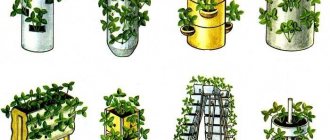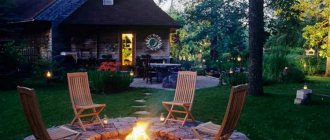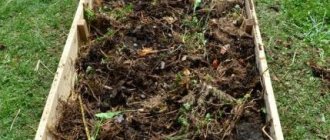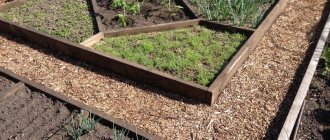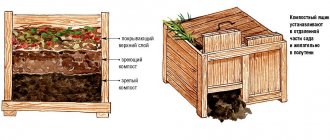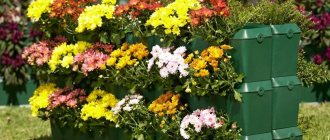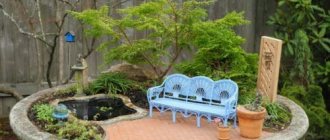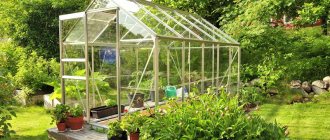Features of the French vegetable garden
Every gardener can make a French vegetable garden according to the scheme. The main thing is to understand the principles of arranging this type of territory, to choose the right plants, taking into account the common style and the desire to obtain a harmonious result. French high beds made of WPC are an interesting alternative to classic plots with dull rows of plantings.
There are many options for designing a French vegetable garden; you can choose a ready-made sketch or create it yourself
How is it different from normal
French vegetable gardens are reminiscent of the gardens of Louis XIV. They symbolize harmony, purity, order and beauty. The main features of such landings:
- symmetrical elements;
- geometric figures;
- rectangular shape with internal division into squares;
- the presence of a sundial or sculpture in the center.
You can grow not only vegetables in rows, but also berries and flowers. The principle is simple - the more beautiful, the better.
There must be comfortable, well-maintained paths between the beds.
Preparation stages
Let's summarize. To set up a French garden you need:
- Change the shape of the beds.
- Select the bed visually.
- Surround the garden bed with a border or decorative fence.
- Plant plants.
With the help of a French vegetable garden, you will turn your plot into a relaxation area. If desired, you can place a pergola with clematis or climbing roses, decorative hanging plants, sculptures, and lanterns near the flower bed.
A French vegetable garden created with your own hands will arouse the envy and admiration of all neighbors and attract the glances of passers-by. And on a summer evening it will allow you to relax after a busy day and enjoy the results of your work.
Advantages and disadvantages
French vegetable gardens have many more advantages than disadvantages. But you need to understand that such a solution is more beautiful than practical. Its advantages:
- unusual, very neat appearance;
- the possibility of using as an alternative to conventional beds and flower beds;
- placement of accents, decor of territories;
- minimum time for disembarkation (comparatively);
- the inclination of fenced beds to spontaneous growth.
The shapes and sizes of decorative elements can be any at the discretion of the owner of the site.
Important! It is necessary to take into account the rules of floristry when designing a site. This is the only way to achieve harmonious plantings. A plot like a French vegetable garden always looks very neat
The French garden also has certain disadvantages. Not all of the usable area of the plot will be used for planting crops - this is the price to pay for beauty and original, well-groomed forms.
Since the allotment consists of separate parts of regular geometric shapes, not every crop is suitable for its design. When arranging paths and fences, appropriate materials are used, which means additional costs.
Multi-level structures
This technique is used mainly for decorative purposes - beds raised to different heights look very impressive. It makes sense to build such structures even if there is not enough space for planting. However, their number is always limited. Caring for plants growing in multi-tiered structures is always more difficult.
Plus, only crops that have a poorly developed root system need to be planted in such structures: some varieties of flowers, strawberries, lettuce, parsley, dill and other types of greens. Low-growing varieties of tomatoes also look very decorative in such beds.
To build multi-tiered beds, you can knock down special boxes from wood. It is highly undesirable to use metal - it heats up quickly in the sun, and the soil in them will dry out even faster. If necessary, paint metal containers with light paint - light surfaces heat up less.
Ready-made boxes, racks or containers of suitable size are often used for such structures. You can also place large containers filled with soil on the shelves.
Design options for French beds
The following methods of designing beds are available:
- The sectors are distinguished by correct geometry; strict symmetry of the beds is required. There are no placement standards as such, but the style should be uniform. Sectors must have clear geometric dimensions
- Visually, well-groomed areas are more reminiscent of gardens with flower beds of vegetables and flowers that appear in a given sequence. French beds are more like flower beds, this is their main difference from conventional plantings
- Some sectors are raised above the soil, others are located slightly lower. This creates a layered effect. Many beds are made on a hill, which allows you to keep the garden clean
- The paths are well-groomed, smooth, neat. To prevent overgrowth, they are paved with tiles and then covered with gravel. You can do not backfill, but sow plants. To cover the path, you can use not only crushed stone, but also any small, non-sharp stones
It is not easy to decorate the territory using the methods described, but the results will be excellent.
Choosing a place
It is recommended to place French beds in the most visible place on the site. In this case, the best option would be to design the beds in a checkerboard pattern or in the form of a square.
Another point also influences the choice of location. The layout depends on whether you plan to do the planting work manually or use special equipment.
How to make a French vegetable garden at your dacha with your own hands
Judging by the photo, it’s not difficult to make a French vegetable garden with your own hands, but it is advisable to first stock up on drawings of the option you like. They will help you mark out the areas before starting work.
Layout
Before you create photos, diagrams and drawings for your French garden with your own hands, you need to carefully study the landscape and analyze its features. A significant factor is the direction of the wind; you also need to take into account the degree of illumination of the area, the presence or absence of a solid fence. It is desirable that the beds are visible from different areas of the site.
Important! Lighting is very important for growing primarily garden crops. Sectors should not be located under trees or in the shade of a house.
The sizes and shapes of the beds are calculated taking into account the methods of performing excavation work. Paths must be wide enough if you plan to walk on them. 6 acres is not enough for a full-fledged vegetable garden, but the main area can be decorated. Be sure to carefully consider drainage, since stagnant water is harmful to both the plants and the site in general.
A small French vegetable garden should be well-groomed, watering can be conveniently done by drip
You should definitely study the composition of the soil to understand whether it is suitable for a particular type of plant. Perhaps one crop needs black soil, another needs a soil mixture. It is desirable to have sand - up to 30% of the total mass to loosen it.
Important! You can make soils yourself or buy ready-made ones at a farm store.
Before work, it is advisable to draw a diagram of the future garden, mark where things will grow, and sketch with flowers. This will allow you to determine the optimal number of consumables and seedlings.
Rectangular shapes are most often used when arranging French plantings.
In the center of the plantings, you need to think over a decorative element, the main part of the composition. This is usually a sculpture, lamp, or other similar structure. If you don’t like rectangular beds, you can choose a semicircle, chess, or spiral. Paths can be decorated to your taste
Arrangement of beds
Various methods are used to form sectors. It is optimal to raise the plantings 20-30 cm above the ground, then separate them with a small border. An alternative solution is that the beds will not protrude above the ground.
There are a lot of design options for French beds - pots, sectors, flower beds, you can create imaginary shapes
Raised beds are an important component of the French vegetable garden; it allows you to form the correct cells of given sizes and shapes that will maintain their appearance for a long time. Usually the protruding part is small - up to 50 cm. The width of the sector will depend on the processing side - one or two. The cells are made arbitrary.
Raised forms have many advantages, the main ones are:
- possibility of arrangement on concrete, stone and other surfaces unsuitable for free growing of plants;
- protection against trampling;
- arrangement of reliable drainage.
Before equipping the territories, the site is usually covered with a layer of sand; it should be located several centimeters above the ground level. This will be the drainage for paths and beds. Afterwards, fertile soils are filled in, the choice of which depends on the type of crop.
French vegetable gardens are easy to care for; even during watering, there is no risk of the plantings being washed away, as in conventional garden beds.
Slate or wooden boards are used for fencing. Their dimensions are calculated taking into account the fact that 100 mm will need to be dug into the ground. To make the fence strong, stakes are driven into the ground along the perimeter of the beds, and pieces of slate are attached to them with self-tapping screws. If you want to simplify the work as much as possible, you can buy ready-made plastic sheets.
Important! Small wicker fences and rows of bottles turned upside down look interesting at dachas. Brick is less common, but is also used.
For borders, a grid is often used - a couple of rows are enough. Between them you will need to put stones, gravel or other material. To prevent it from spilling out, geotextiles are fixed.
Low beds are the neatest, they can be made to any length
Afterwards, you can begin to fill in the soil mixture and plant garden crops. The work is not difficult, but quite painstaking.
A French vegetable garden made of concrete cells has its advantages; it is more durable, unlike a wooden one
What plants are best to plant?
You can use virtually any plants for arranging a French garden, the main thing is that they meet the following requirements:
- harmonious compatibility with each other, the same agricultural requirements (presence of light, moisture);
- the ability to grow in the neighborhood without causing inconvenience or reducing productivity.
If flowers grow between the vegetables, the planting scheme is thought out so that the mini-flower beds do not interfere with the normal growth of crops.
If desired, you can make not rectangular, but shaped beds, choosing unpretentious plants as edging
The presence of plants that play the role of vertical perennial elements is mandatory. They can be temporary or permanent. Greens are also grown in French gardens; different flowers and plants are used to create variety in the color palette of a summer cottage. You can combine different herbs with vegetables. It is not necessary to focus only on the listed varieties; you can choose any others.
Think through the planting scheme in advance. So, low varieties are usually placed around the perimeter, tall vegetables are planted closer to the center. Along the outer part there are plants that can reliably protect the internal parts of the plantings from cold winds. Potatoes and cucumbers are acceptable in French gardens, but undesirable, as they spoil the appearance of the beds.
Important! An ideal option for protecting plantings are fruit and herbaceous shrubs.
If there are aggressive plants like oregano and mint, they are grown in a separate sector
It is highly undesirable to mix annuals and perennials. When cultivating the soil, the risk of damaging the roots of perennials will increase. Compatibility is also important. So, onions love parsley and carrots, chamomile loves red monarda, cornflowers. Celery, dill, fennel, and sage usually do not conflict.
Vegetables and flowers, greens can be combined in one garden bed if they have the same requirements for external conditions
What do we plant: berries, vegetables or herbs?
In a French garden you can plant whatever you can think of. This will be your personal preference and taste. But do not forget to follow some principles so as not to disturb the harmony of the garden.
You need to choose plants based on their light-loving nature, flowering time, size and fruiting. Some gardeners like to have greens and herbs growing in their beds, but if you add beds of garlic, radishes or carrots, they will fit perfectly into your ornamental garden.
You can plant any crops that you like.
To add color to your beds, add several varieties of lettuce or a variety of low-growing flowers.
It would be good to plant fruit trees and shrubs around the perimeter of the garden, which, in addition to tasty fruits, will help protect your garden from the cold wind.
